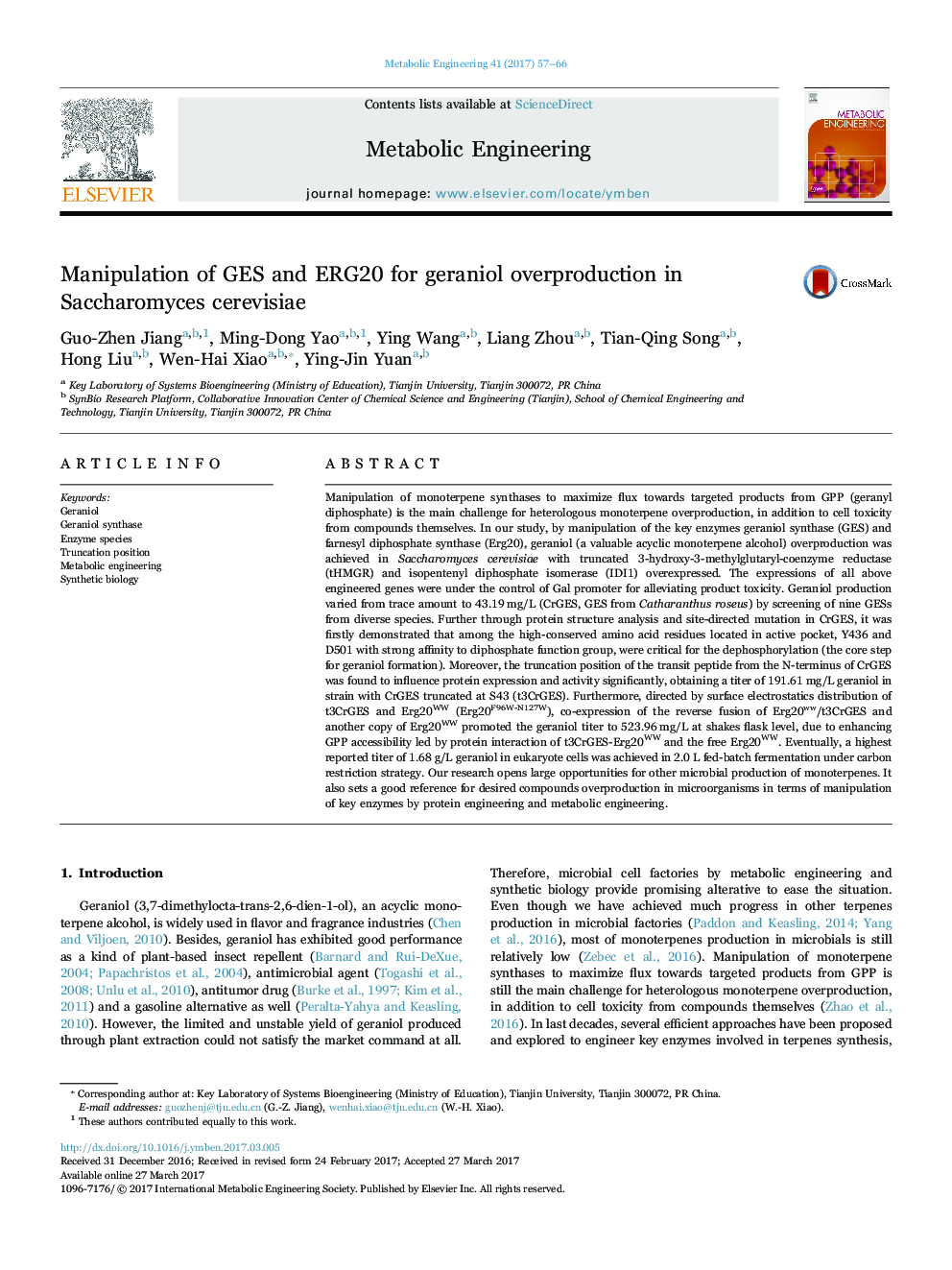| کد مقاله | کد نشریه | سال انتشار | مقاله انگلیسی | نسخه تمام متن |
|---|---|---|---|---|
| 6452675 | 1418337 | 2017 | 10 صفحه PDF | دانلود رایگان |

- Geraniol overproduction was obtained by manipulation of the key enzymes GES and Erg20WW in S.cerevisiae.
- CrGES was the best enzyme for geraniol overproduction. Two essential amino acid residues Y436 and D501 located in active pocket of CrGES were firstly identified to be critical for the dephosphorylation (the core step for GES function).
- Geraniol production was further enhanced by tailoring the trunction of CrGES via balancing its catalytic actitity and functional expression level.
- Guided by protein surface electrostatics distribution, co-expression of the reverse fusion of Erg20WW/t3CrGES and another copy of Erg20WW presented the best GPP accessibility for geraniol accumulation.
- A highest reported titer of 1.68Â g/L geraniol in eucaryote cells was achieved.
Manipulation of monoterpene synthases to maximize flux towards targeted products from GPP (geranyl diphosphate) is the main challenge for heterologous monoterpene overproduction, in addition to cell toxicity from compounds themselves. In our study, by manipulation of the key enzymes geraniol synthase (GES) and farnesyl diphosphate synthase (Erg20), geraniol (a valuable acyclic monoterpene alcohol) overproduction was achieved in Saccharomyces cerevisiae with truncated 3-hydroxy-3-methylglutaryl-coenzyme reductase (tHMGR) and isopentenyl diphosphate isomerase (IDI1) overexpressed. The expressions of all above engineered genes were under the control of Gal promoter for alleviating product toxicity. Geraniol production varied from trace amount to 43.19Â mg/L (CrGES, GES from Catharanthus roseus) by screening of nine GESs from diverse species. Further through protein structure analysis and site-directed mutation in CrGES, it was firstly demonstrated that among the high-conserved amino acid residues located in active pocket, Y436 and D501 with strong affinity to diphosphate function group, were critical for the dephosphorylation (the core step for geraniol formation). Moreover, the truncation position of the transit peptide from the N-terminus of CrGES was found to influence protein expression and activity significantly, obtaining a titer of 191.61Â mg/L geraniol in strain with CrGES truncated at S43 (t3CrGES). Furthermore, directed by surface electrostatics distribution of t3CrGES and Erg20WW (Erg20F96W-N127W), co-expression of the reverse fusion of Erg20ww/t3CrGES and another copy of Erg20WW promoted the geraniol titer to 523.96Â mg/L at shakes flask level, due to enhancing GPP accessibility led by protein interaction of t3CrGES-Erg20WW and the free Erg20WW. Eventually, a highest reported titer of 1.68Â g/L geraniol in eukaryote cells was achieved in 2.0Â L fed-batch fermentation under carbon restriction strategy. Our research opens large opportunities for other microbial production of monoterpenes. It also sets a good reference for desired compounds overproduction in microorganisms in terms of manipulation of key enzymes by protein engineering and metabolic engineering.
Journal: Metabolic Engineering - Volume 41, May 2017, Pages 57-66